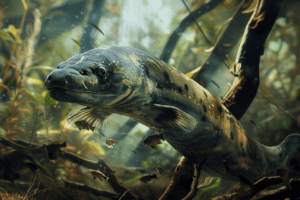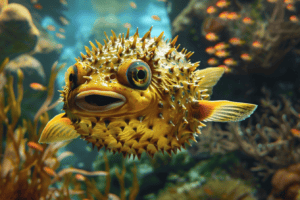Megamouth sharks are one of the world’s most mysterious creatures.
These giants of the deep are rarely seen by humans, and much of what we know about them comes from the few specimens that have been caught or washed up on shore.
Despite their elusive nature, however, megamouth sharks have captured the imagination of scientists and the public alike.

At first glance, megamouth sharks might seem like just another species of shark, but they are actually quite unique.
They are one of only three species of shark that are filter feeders, meaning they feed on plankton and small fish by filtering the water through their gills.
Megamouth sharks are also one of the largest species of shark, growing up to 18 feet long and weighing over 2,500 pounds.
Despite their massive size, they are gentle creatures that pose no threat to humans.
Despite their impressive size and unique feeding habits, much about megamouth sharks remains a mystery.
Scientists are still trying to understand their behavior, migration patterns, and population size.
In this article, we will explore what we know about these fascinating creatures, and what questions remain unanswered.
Get ready to dive into the world of megamouth sharks and discover the secrets of these giants among us.
Discovering the Megamouth

First Discovery
The Megamouth Shark is a fascinating creature that was discovered in 1976.
The first-ever sighting of this elusive shark was made by a US Navy research vessel off the coast of Hawaii.
The scientists on board were stunned by the size and unique features of the shark. They had never seen anything like it before.
The Megamouth Shark is named after its enormous mouth, which can reach up to 4 feet wide. It has a long, slender body that is dark gray in color.
The shark’s skin is covered in tiny, tooth-like scales called dermal denticles, which help to reduce drag as it swims through the water.
Rarity and Research
Since the first discovery, only around 100 Megamouth Sharks have been observed and studied by scientists.
This is because the shark is extremely rare and elusive, and is only found in deep waters around the world.
Despite its rarity, scientists have been able to learn a lot about the Megamouth Shark through careful observation and research.
They have discovered that the shark is a filter feeder, meaning that it feeds on plankton and small fish by filtering them through its enormous mouth.
Scientists have also discovered that the Megamouth Shark is a slow swimmer, and that it has a unique way of swimming that helps it to conserve energy.
By flapping its large pectoral fins, the shark is able to glide through the water with minimal effort.
Overall, the Megamouth Shark is a remarkable creature that continues to intrigue and fascinate scientists and the general public alike.
Its unique features and elusive nature make it a true giant among us.
Fun Fact: The Megamouth Shark is one of the three species of filter-feeding sharks, along with the Whale Shark and Basking Shark.
Anatomy of a Gentle Giant
Distinctive Features
Megamouth sharks are named for their enormous heads and wide mouths. Their mouth can open up to 1.3 meters wide, revealing hundreds of tiny teeth.
They have a rounded snout and a soft, flabby body that is dark blue-gray on top and white on the bottom.
Their skin is covered in small, tooth-like scales called dermal denticles, which help reduce drag as they swim through the water.
One of the most distinctive features of the megamouth shark is the photophores on its body.
These are light-producing organs that help attract prey and communicate with other sharks.
Megamouth sharks have photophores on their belly, which they use to mimic the light of the moon and stars.
This makes them difficult for prey to see from below and helps them blend in with the surrounding water.
Size Comparison
Megamouth sharks are one of the largest species of shark, but they are not as well-known as other giants like the great white or the whale shark.
They can grow up to 5.5 meters long and weigh over 1,000 kg.
This makes them larger than most other deep-sea sharks but smaller than a great white or a whale shark.
To put their size into perspective, imagine a megamouth shark swimming next to a school bus.
The shark would be longer than the bus and weigh almost as much as a small car.
Despite their size, megamouth sharks are gentle giants that pose little threat to humans.
They are filter feeders, which means they eat plankton and small fish by filtering them out of the water with their gill rakers.
In conclusion, the megamouth shark has a unique set of features that make it stand out from other shark species.
Their enormous head, wide mouth, and photophores make them fascinating to study and observe.
Although they are one of the largest sharks in the ocean, they are not aggressive towards humans and pose no danger to us.
Habitat and Behavior

Ocean Homes
Megamouth sharks are deep-water creatures that can be found in oceans around the world.
They typically inhabit waters deeper than 500 feet, but have been known to venture into shallower areas.
These sharks are most commonly found in the Pacific Ocean, but have also been spotted in the Indian and Atlantic Oceans.
Megamouth sharks prefer to stay in areas with steep drop-offs, where they can easily move between depths.
They also tend to congregate near underwater mountains and seamounts, where currents bring nutrient-rich waters up from the ocean floor.
Feeding Habits
Megamouth sharks are filter feeders, meaning they consume small organisms by filtering them out of the water.
They have a large, gaping mouth that can expand to almost 4 feet wide, allowing them to take in large amounts of water.
As they swim, water flows over their gill rakers, which act like a sieve, trapping plankton, krill, and small fish.
Interestingly, megamouth sharks have been known to feed at night, when plankton and other small organisms rise to the surface.
They may also feed during the day in deeper waters, where they can find larger prey.
Megamouth sharks are not known to be aggressive towards humans and are rarely encountered due to their deep-water habitat.
However, they are still considered a vulnerable species due to their slow reproductive rate and low population numbers.
Conservation and Human Interaction

Threats to Survival
Megamouth sharks are one of the rarest shark species on the planet, and their population size is unknown.
However, they are considered to be vulnerable to extinction due to their low reproductive rates and the increasing threats they face from human activities.
One of the biggest threats to megamouth sharks is accidental entanglement in fishing gear.
These sharks are often caught as bycatch in deep-sea fisheries targeting other species, such as tuna and swordfish.
The accidental capture of megamouth sharks can result in their injury or death, which can further reduce their already small population size.
Another threat to megamouth sharks is habitat destruction.
These sharks are found in deep waters, and their habitats are being destroyed by human activities such as deep-sea mining, oil and gas exploration, and bottom trawling.
Conservation Efforts
To protect megamouth sharks and ensure their survival, various conservation efforts are being undertaken.
One such effort is the establishment of marine protected areas (MPAs) in areas where megamouth sharks are known to occur.
MPAs limit or prohibit fishing and other human activities, which can help to protect the habitats of these sharks and reduce accidental entanglement in fishing gear.
Another conservation effort is the development of fishing gear that is less harmful to megamouth sharks.
For example, the use of circle hooks instead of J-hooks can reduce the likelihood of accidental capture and injury to these sharks.
Public education and outreach programs are also important for raising awareness about the importance of megamouth sharks and the threats they face.
By educating the public about these sharks and their habitats, we can encourage people to take action to protect them.
In conclusion, megamouth sharks are an important and fascinating species that are vulnerable to extinction due to human activities.
However, by taking action to protect their habitats and reduce accidental capture, we can help to ensure their survival for future generations to enjoy.
Frequently Asked Questions

How big can a megamouth shark grow?
Megamouth sharks are one of the largest species of sharks in the world and can grow up to 18 feet long.
The average length of an adult megamouth shark is around 13 feet.
What do megamouth sharks typically eat?
Megamouth sharks are filter feeders, which means they primarily eat plankton, small fish, and squid.
They have a large mouth that can expand to engulf large amounts of water, which they filter through their gill rakers to extract their prey.
How long do megamouth sharks live?
The lifespan of a megamouth shark is not well understood, but it is estimated to be around 100 years.
Can you tell me about the dental structure of a megamouth shark?
Megamouth sharks have small, pointed teeth that are not used for biting or chewing prey.
Instead, they use their gill rakers to filter out plankton and other small organisms from the water.
What is the estimated population of megamouth sharks in the ocean?
The population of megamouth sharks is not well known, but it is believed to be relatively small.
As of now, there have been only a few hundred confirmed sightings of megamouth sharks worldwide.
How much does an average megamouth shark weigh?
The weight of an average megamouth shark is around 2,600 pounds. However, some individuals have been known to weigh up to 2.5 tons.









